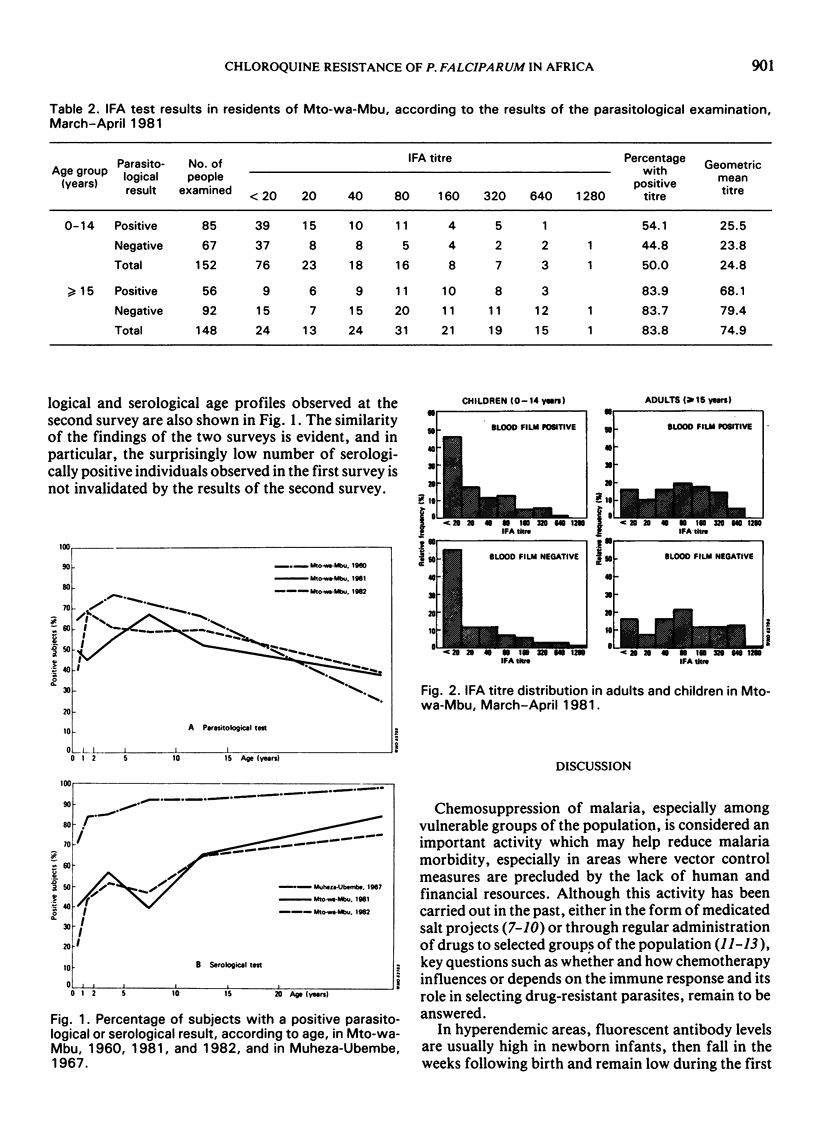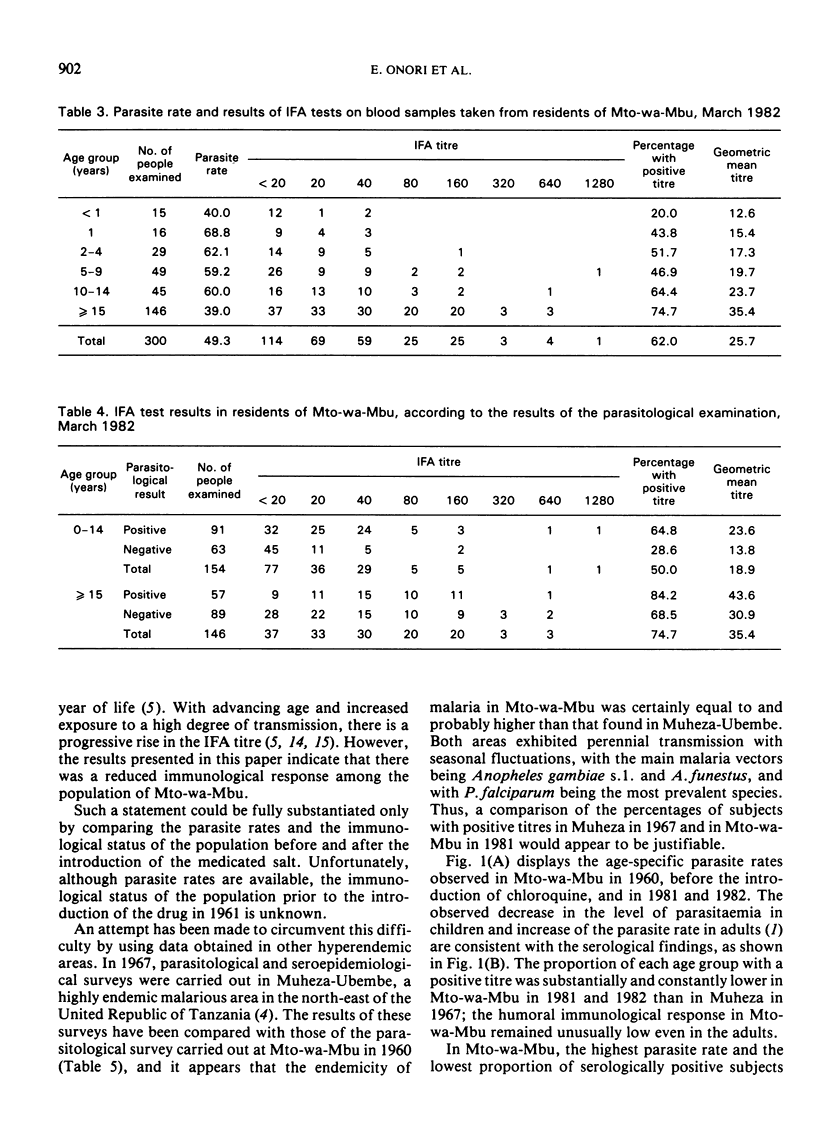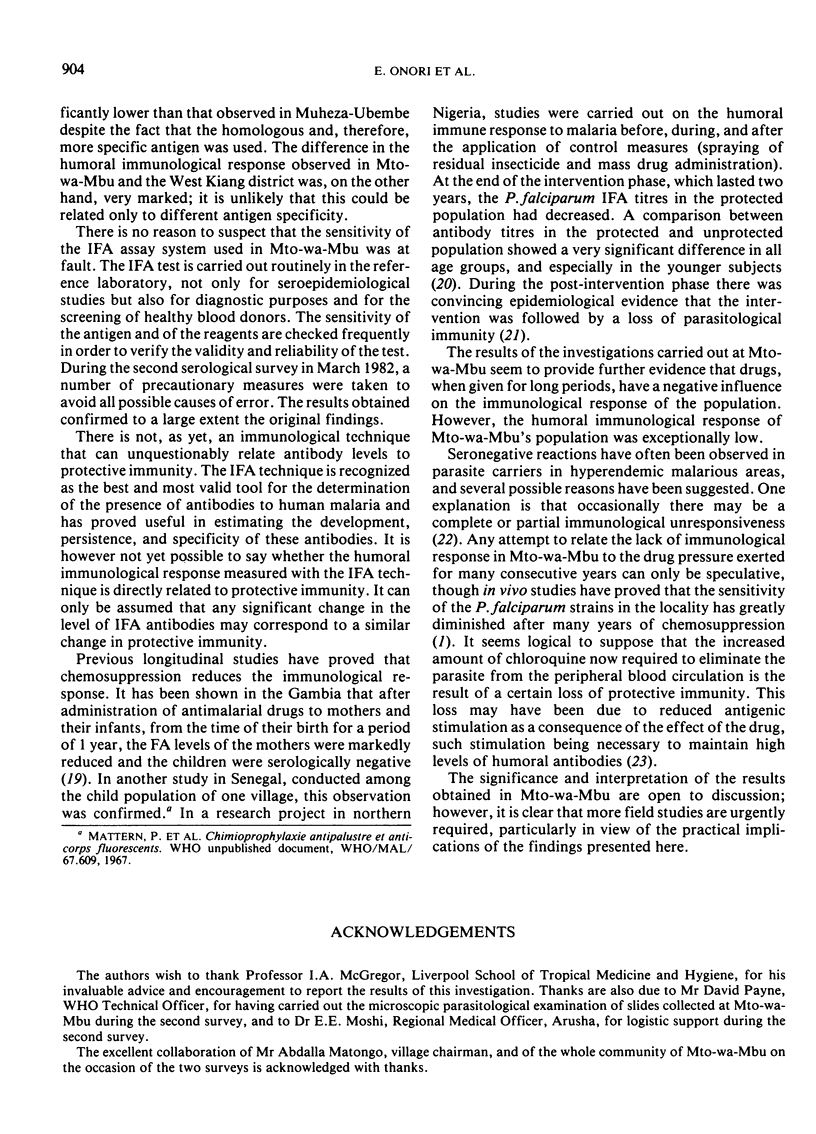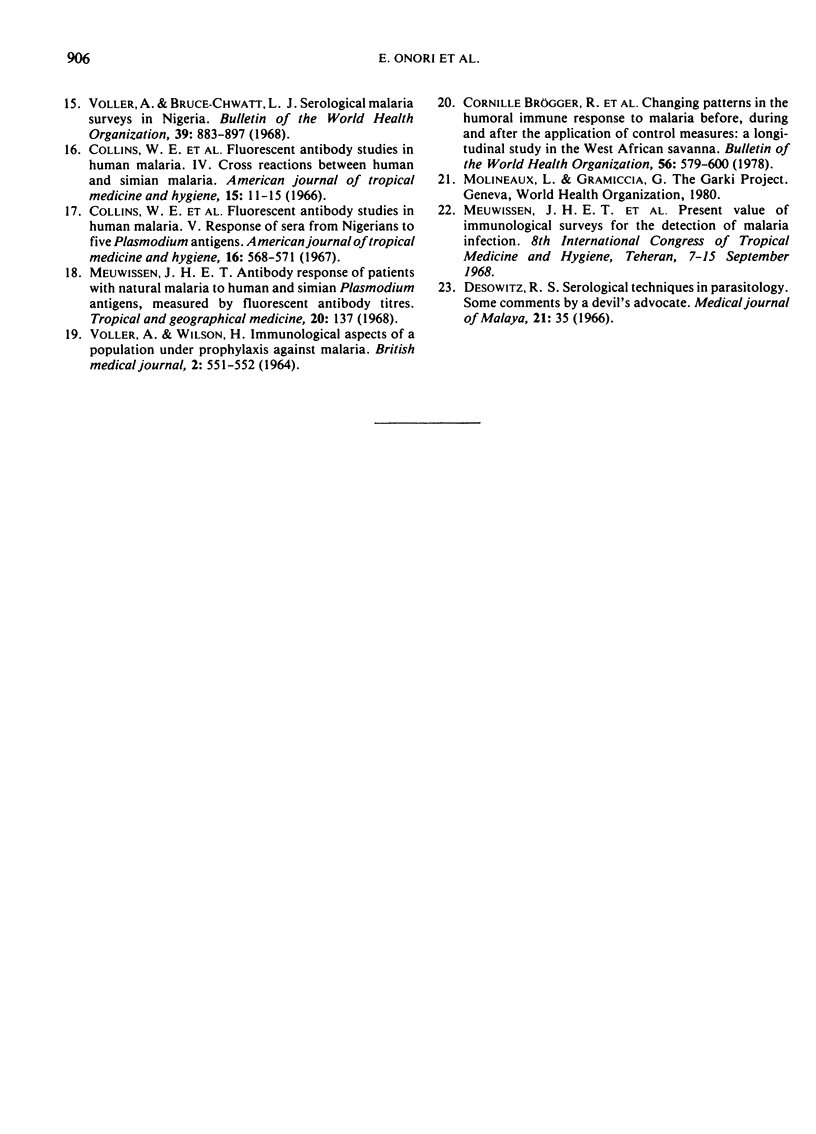Abstract
Decreased sensitivity and incipient resistance of Plasmodium falciparum strains to chloroquine have been reported from Mto-wa-Mbu, in the north-east of the United Republic of Tanzania. In this locality the population had been exposed to chloroquine pressure for about two decades, in the form of medicated salt and through easy availability of the drug itself. In an attempt to find out whether such chemosuppression had influenced the immune response of the population, two seroepidemiological surveys were carried out in March 1981 and March 1982; the second survey was performed to confirm the results obtained in the first one. The humoral immunological response was measured by the immunofluorescent antibody technique. In the absence of information on the immunological profile that existed in the area prior to the introduction of chloroquine in 1960, the results of the present surveys were compared with those obtained in another locality in the north-east of the United Republic of Tanzania in 1967, and in the West Kiang district of Gambia in 1965. The two areas used for comparison exhibited a malaria endemicity similar to that prevailing in Mto-wa-Mbu prior to the introduction of the medicated salt. The results from Mto-wa-Mbu showed a significantly lower proportion of subjects with positive titres and a lower geometric mean titre in all age groups.
A reduction in the humoral immunological response might be explained by the drug pressure that has been exerted in the area for many years. The depressed immune response found at Mto-wa-Mbu, however, was so marked that other factors may have contributed to its establishment.
In view of the importance of these findings, it is recommended that further, longitudinal serological studies be conducted in the field to assess the effects of chemosuppression on the immune response of the protected populations.
Full text
PDF







Selected References
These references are in PubMed. This may not be the complete list of references from this article.
- Ambroise-Thomas P., Wernsdorfer W. H., Grab B., Cullen J., Bertagna P. Etude séro-épidémiologique longitudinale sur le paludisme en Tunisie. Bull World Health Organ. 1976;54(4):355–367. [PMC free article] [PubMed] [Google Scholar]
- Collins W. E., Skinner J. C., Coifman R. E. Fluorescent antibody studies in human malaria. V. Response of sera from Nigerians to five Plasmodium antigens. Am J Trop Med Hyg. 1967 Sep;16(5):568–571. doi: 10.4269/ajtmh.1967.16.568. [DOI] [PubMed] [Google Scholar]
- Cornille-Brögger R., Mathews H. M., Storey J., Ashkar T. S., Brögger S., Molineaux L. Changing patterns in the humoral immune response to malaria before, during, and after the application of control measures: a longitudinal study in the West African savanna. Bull World Health Organ. 1978;56(4):579–600. [PMC free article] [PubMed] [Google Scholar]
- FERREIRA M., ALMEIDA D., BORGESJUNIORLDE S., PAULINI E., ALENCAR T., MARTINS C., LEAL H. ENSAIOS COM SAL MEDICAMENTOSO E CLOROPRIM NA ILHA DE S AO FRANCISCO DO SUL, SANTA CATARINA. Rev Bras Malariol Doencas Trop. 1963 Oct-Dec;15:601–609. [PubMed] [Google Scholar]
- Giglioli G., Rutten F. J., Ramjattan S. Interruption of malaria transmission by chloroquinized salt in Guyana, with observations on a chloroquine-resistant strain of Plasmodium falciparum. Bull World Health Organ. 1967;36(2):283–301. [PMC free article] [PubMed] [Google Scholar]
- JONCOUR G. La lutte contre le paludisme à Madagascar. Bull World Health Organ. 1956;15(3-5):711–723. [PMC free article] [PubMed] [Google Scholar]
- MCGREGOR I. A., WILLIAMS K., VOLLER A., BILLEWICZ W. Z. IMMUNOFLUORESCENCE AND THE MEASUREMENT OF IMMUNE RESPONSE TO HYPERENDEMIC MALARIA. Trans R Soc Trop Med Hyg. 1965 Jul;59:395–414. doi: 10.1016/0035-9203(65)90057-x. [DOI] [PubMed] [Google Scholar]
- Meuwissen J. H. Antibody responses of patients with natural malaria to human and simian plasmodium antigens measured by the fluorescent antibody test. Trop Geogr Med. 1968 Jun;20(2):137–140. [PubMed] [Google Scholar]
- Onori E., Payne D., Grab D., Grab B., Horst H. I., Almeida Franco J., Joia H. Incipient resistance of Plasmodium falciparum to chloroquine among a semi-immune population of the United Republic of Tanzania. 1. Results of in vivo and in vitro studies and of an ophthalmological survey. Bull World Health Organ. 1982;60(1):77–87. [PMC free article] [PubMed] [Google Scholar]
- Otieno L. H., Lelijveld J., Meuwissen J. H., Verbeek A. M., Doesburg W. H. Serological studies of malaria in East Africa. I. Sero-epidemiological survey in a highly endemic malarious area. Trop Geogr Med. 1971 Dec;23(4):369–375. [PubMed] [Google Scholar]
- SCHNEIDER J., LANGUILLON J., DELAS A. Association chioroquine-pyriméthamine dans la chimioprophylaxie du paludisme; résultats après 22 mois de traitement. II. Bull Soc Pathol Exot Filiales. 1958 May-Jun;51(3):316–319. [PubMed] [Google Scholar]
- Trager W., Jensen J. B. Human malaria parasites in continuous culture. Science. 1976 Aug 20;193(4254):673–675. doi: 10.1126/science.781840. [DOI] [PubMed] [Google Scholar]
- VOLLER A., WILSON H. IMMUNOLOGICAL ASPECTS OF A POPULATION UNDER PROPHYLAXIS AGAINST MALARIA. Br Med J. 1964 Aug 29;2(5408):551–552. doi: 10.1136/bmj.2.5408.551. [DOI] [PMC free article] [PubMed] [Google Scholar]
- Voller A., Bruce-Chwatt L. J. Serological malaria surveys in Nigeria. Bull World Health Organ. 1968;39(6):883–897. [PMC free article] [PubMed] [Google Scholar]


